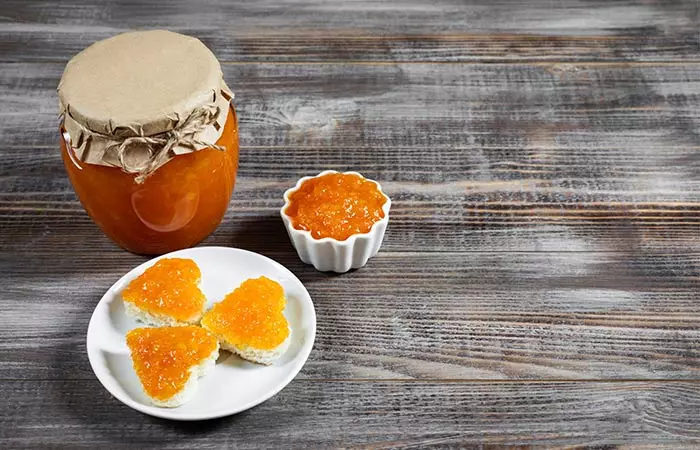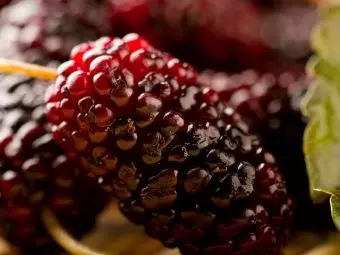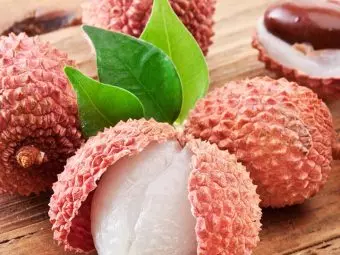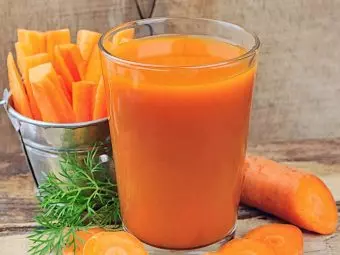Fruits taste best when consumed fresh and help you get all the benefits they offer. But there is a fruit that tastes best when it is rotten. It is the medlar fruit. The benefits of medlar fruit are gaining attention slowly. This fruit belongs to the Rosaceae family and is grown in autumn. It is harvested raw and rotten, and fermented before consumption. Continue reading to know more about medlar fruit, its nutrition, recipes you can try with it, and how can you include this fruit in your diet.
In This Article
What is Medlar Fruit? History And Origin
The medlar is a pome fruit from the Rosaceae family, closely related to quinces, pears, and apples. Originally from southwestern Asia, it was brought initially to Greece and Italy and later on, to the whole of Europe. Interestingly, this fruit has been mentioned in Shakespeare’s Romeo and Juliet.
The fruit is unusual for two reasons.
- They are harvested in late autumn, mostly in November and December, making them an important source of sugar in the cold winters.
- They can be eaten only when they’re rotten.
Medlar fruits are picked raw in late autumn and are allowed to rot beyond ripening, a process called “bletting”. They are usually stored in a cool dry place until they become soft and mushy and darker brown in color. It then takes on a sweet and slightly acidic flavor. These can then be eaten directly scooped out of the fruit or can be baked, roasted, or made into jelly, tarts, cider, wine, or brandy.
Fun FactMedlar fruit had several vulgar nicknames in southwestern England, such as “monkey’s bottom” and “open-arse” due to its appearance, especially the large calyx.
Medlars, though not as known and widely found as apples and pears, are regaining their use and popularity because of their abundance in nutrition.
Nutritional Information Of Medlar Fruit
The medlar fruit is rich in nutrition and healthy components. It contains significant amounts of amino acids, tannins, sugars, pectins, and organic acids (1). These add up to give it the characteristic sweet yet tart flavor.
Medlar contains nutrients such as carotene, vitamin C, and vitamin B complex. It is also a rich source of calcium, potassium, iron, magnesium, sodium, and phosphorus that are found in smaller yet significant concentrations (2), (3).
Medlar fruit, with its phenolic compounds, flavonols, and ascorbic acid can also be an important source of natural antioxidants (4).
With the above important nutrients, medlar can provide you with a host of health benefits as discussed below.
Potential Health Benefits Of Medlar Fruit

Shutterstock
The medlar fruit helps in treating intestinal infections and inflammations, menstrual irregularities, diarrhea, stomach bloating, internal bleeding, and strengthens the nerves as well (5). It offers the following benefits as well:
Related: 10 Natural Remedies For Diarrhea + Causes, Symptoms, And Prevention Tips
- Rich In Antioxidants
Common medlar is a natural source of polyphenolic compounds, particularly phenolic acids that show strong antioxidant properties. The medlar fruit, bark, and leaves all contain significant amounts of plant flavonoids and polyphenols (6). The consumption of food rich in polyphenols has been associated with a reduced risk of several diseases such as atherosclerosis and diabetes (7), (8).
- Anti-inflammatory And Antibacterial Properties
Gallic acid is a polyphenol found in the highest proportion in medlar extracts (6). Gallic acid, with its anti-inflammatory properties, might be instrumental in reducing fat storage in obese people (9). Simultaneously, it might have potential antibacterial activity against food-related Pseudomonas strains (10). This means a possible application of medlar extracts in the food preservation industry as well.
- Rich In Immunity-boosting Minerals

Shutterstock
Calcium, potassium, magnesium, iron, and other minerals found in medlar fruit help boost overall immunity. With its rich content of vitamin C, medlars also hold the potential to help treat scurvy (2), (11).
- Rich In Health-promoting Pectin
Pectin is a good source of dietary fiber derived from the cell walls of plants. Medlar fruit with its rich pectin content may help reduce cholesterol levels, prevent constipation, and stimulate bowel activity along with its other anti-inflammatory effects (12), (13).
- Might Help Treat Diabetes

Shutterstock
Polyphenols found in medlar, especially phenolic acids, and flavonoids are known to inhibit α-glucosidase and α-amylase in carbohydrate metabolism. This can be useful in the formulation of medicines and nutraceuticals significant for diabetes treatment (14), (15).
Related: Glucerna For Diabetes: How It Works And Nutritional Facts
- Might Help Prevent Alzheimer’s Disease
As per a study on rats, high levels of flavonoids in the medlar fruit might be effective in the prevention of memory loss and neural injury. This could be further investigated for potential treatment options of similar neurodegenerative diseases in humans (16).
With knowledge of the medlar health benefits above, let’s explore the many ways you can include them in your diet.
Related: Top 10 Yoga Poses To Improve Your Memory
How to Use Medlar Fruit In Your Diet?
When ripe, the medlars can burst open easily at the slightest touch, so you need to be careful while taking the pulp out. Gently peel off the stalk and squeeze out the pulp holding at the crown. Remove the seeds before eating.
Once ripe, medlars can either be eaten raw or can be used in a number of ways as follows:
- It can be easily made into jams, jellies, marmalade, or syrups.
- Medlar can also be consumed as candied fruit or with cheese as a dessert.
- The fruit pulp with eggs and butter can be made into medlar cheese.
- Unripe fruit can be pickled with vinegar and sugar.
- Medlar can also be used as a condiment in making fruit wine (17).
- Can be made into a thick sauce that enhances many meat dishes.
SubscribeStylecraze TriviaRipe medlar is hard and acidic. However, once bletting starts, its flesh softens, turns brown and soft, and develops an applesauce-like flavor.
Let us help you with some popular medlar recipes in case you happen to come across this hidden gem of fruit.
Popular Recipes Of Medlar
1. Compote Of Ripe Medlars

Shutterstock
Ingredients
- medlars (half-ripe) – 1kg
- brown sugar – 800 g or honey – 50 g
- water – 0.5 litres
Instructions
- Wash, clean, and dice the half-ripe medlars into small pieces.
- Dissolve the honey or sugar in water.
- Pour the liquid mixture over the cut medlars.
- Cook on low heat for an hour.
- Cool it down slightly.
- When lukewarm, pour into jars.
- Seal and keep aside.
2. Medlar Jelly

iStock
Ingredients
- medlars – 2kg
- water
- sugar – 375 g per 500ml of strained juice
- lemon (juiced) – 2
Instructions
- Let the medlars ferment and soften.
- Place them in a preserving pan and cover them with sufficient water.
- Bring it to a boil and let it simmer for about 90 minutes to 3 hours (depending on the amount of bletting).
- Strain the mixture through a muslin cloth or jelly bag.
- Do not push the fruit through to avoid a cloudy jelly.
- Measure and add 375g of sugar per 500ml of the strained liquid.
- Add in the lemon juice.
- Bring to a boil and simmer for about 10 minutes until the setting point is reached.
- Pour hot into sterilized jars and seal.
To know if it has set well, place a plate with a spoonful of jelly in your freezer. Let it cool and then run your finger through it. If it parts through and crinkles at the edges, it’s ready. If not, you need to cook the jelly for another 5 minutes.
Now that you know how to include medlar in your diet and its popular recipes, let’s also be aware of its potential side effects.
Possible Side Effects Medlar Fruit
Like other members of the Rosaceae family, the seeds of medlar contain hydro-cyanic acid (prussic acid) and might be poisonous if eaten (5).
Even though the medlar fruit is rich in nutrients and health benefits, the use and intake of medlar seeds should be avoided.
Medlar fruit’s benefits can be attributed to its rich nutrients. When included as a part of your regular diet, this fruit can reduce the risk of diabetes and atherosclerosis as it is rich in antioxidants. In addition, it has antibacterial and anti-inflammatory properties. Medlar fruit can boost immunity and help in managing constipation, cholesterol levels, and diabetes. It may also prevent Alzheimer’s disease. You can add medlar fruit to your diet in the form of jam and jelly, and you can make medlar cheese as well. However, the seeds of medlar fruit are poisonous. Hence, caution is advised.
Frequently Asked Questions
What does medlar wine taste like?
Medlar wine has hints of applesauce and cinnamon. It might remind you of toffee and applesauce with notes of alcohol mixed in.
Can you grow medlars from seeds?
Yes. In order to germinate, the medlar seeds require a cold stimulus and a moist soil environment.
Is medlar tree self pollinating?
Yes. Medlar tree is self-fertile and you do not need another tree for fruiting.
Key Takeaways
- The medlar fruit is rich in amino acids, tannins, sugars, pectins, and organic acids that combine to give it its distinctive sweet yet tart flavor.
- This fruit can be used to treat intestinal infections, menstruation irregularities, diarrhea, bloating, Alzheimer’s disease.
- Do not consume medlar seeds as they can be poisonous.
Sources
Articles on StyleCraze are backed by verified information from peer-reviewed and academic research papers, reputed organizations, research institutions, and medical associations to ensure accuracy and relevance. Read our editorial policy to learn more.
- Changes in sugars organic acids and amino acids in medlar (Mespilus germanica L.) during fruit development and maturation
https://www.sciencedirect.com/science/article/abs/pii/S0308814603000979?via%3Dihub - Effect of Five Different Stages of Ripening on Chemical Compounds in Medlar (Mespilus germanica L.)
https://www.ncbi.nlm.nih.gov/labs/pmc/articles/PMC6259355/ - Mineral composition of medlar (Mespilus germanica) fruit at different stages of maturity
https://www.researchgate.net/publication/230165739_Mineral_composition_of_medlar_Mespilus_germanica_fruit_at_different_stages_of_maturity - Phytochemical and antioxidant characteristics of medlar fruits (Mespilus germanica L.)
https://www.researchgate.net/publication/232259484_Phytochemical_and_antioxidant_characteristics_of_medlar_fruits_Mespilus_germanica_L - Medicinal benefits and usage of medlar (Mespilus germanica) in Gilan Province (Roudsar District) Iran
https://academicjournals.org/journal/JMPR/article-abstract/6669A2526228 - Functional Properties of Fruits of Common Medlar (Mespilus germanica L.) Extract
https://www.mdpi.com/2076-3417/11/16/7528/htm#B53-applsci-11-07528 - Flavonoids as antioxidants
https://pubmed.ncbi.nlm.nih.gov/10924197/ - Antidiabetic Effects of Simple Phenolic Acids: A Comprehensive Review
https://pubmed.ncbi.nlm.nih.gov/26634804/ - Inflammation and Oxidative Stress in an Obese State and the Protective Effects of Gallic Acid
https://pubmed.ncbi.nlm.nih.gov/30577684/ - Antimicrobial activity of gallic acid against food-related Pseudomonas strains and its use as biocontrol tool to improve the shelf life of fresh black truffles
https://pubmed.ncbi.nlm.nih.gov/29227905/ - Scurvy
https://www.ncbi.nlm.nih.gov/labs/pmc/articles/PMC2567249/ - Characterization of chemical molecular thermal and rheological properties of medlar pectin extracted at optimum conditions as determined by Box-Behnken and ANFIS models
https://www.sciencedirect.com/science/article/abs/pii/S0308814618313712 - Health-promoting properties of pectin
https://pubmed.ncbi.nlm.nih.gov/24864109/ - Dietary polyphenols as potential nutraceuticals in management of diabetes: a review
https://link.springer.com/article/10.1186/2251-6581-12-43 - Polyphenol Contents and Antioxidant Properties of Medlar (Mespilus germanica L.)
https://www.researchgate.net/profile/Fevzi-Topal-2/publication/267361786_Polyphenol_Contents_and_Antioxidant_Properties_of_Medlar_Mespilus_germanica_L/links/5591134708ae1e1f9bae4a68/Polyphenol-Contents-and-Antioxidant-Properties-of-Medlar-Mespilus-germanica-L.pdf - Effect of Medlar (Mespilus germanica L) fruit and seed flavonoids on learning and memory and also hippocampal CA3 neurons in Alzheimer′s rats
https://www.omicsonline.org/proceedings/effect-of-medlar-mespilus-germanica-l-fruit-and-seed-flavonoids-on-learning-and-memory-and-also-hippocampal-ca3-neurons–57447.html - Chapter 7 – Specific Features of Table Wine Production Technology
https://www.sciencedirect.com/science/article/pii/B9780128008508000077
Was this article helpful?
Related
The following two tabs change content below.
- Author

Varsha Patnaik
Varsha holds a master’s degree in biotechnology from Ravenshaw University, Cuttack, and is a certified diet and nutrition coach. She… more



 23 Amazing Benefits Of Mulberries (Shahtoot) For Skin, Hair, And Health
23 Amazing Benefits Of Mulberries (Shahtoot) For Skin, Hair, And Health 22 Best Benefits Of Oatmeal For Skin, Hair, And Health
22 Best Benefits Of Oatmeal For Skin, Hair, And Health 21 Amazing Benefits Of Litchis (Lychees) For Skin, Hair, And Health
21 Amazing Benefits Of Litchis (Lychees) For Skin, Hair, And Health 10 Nutritional Benefits Of Carrot Juice For Skin, Vision, And Health
10 Nutritional Benefits Of Carrot Juice For Skin, Vision, And Health Honey For Oily Skin – 12 Best Ways To Use It Effectively
Honey For Oily Skin – 12 Best Ways To Use It Effectively Flax Seeds Benefits & DIY Face Masks For Beautiful Skin
Flax Seeds Benefits & DIY Face Masks For Beautiful Skin Parsley: 10 Potential Benefits And Uses, Nutrition, How To Make Tea
Parsley: 10 Potential Benefits And Uses, Nutrition, How To Make Tea 33 Wonderful Benefits Of Banana For Skin, Hair, And Health
33 Wonderful Benefits Of Banana For Skin, Hair, And Health Tea Tree Oil For Warts: Benefits, How To Use, And More
Tea Tree Oil For Warts: Benefits, How To Use, And More